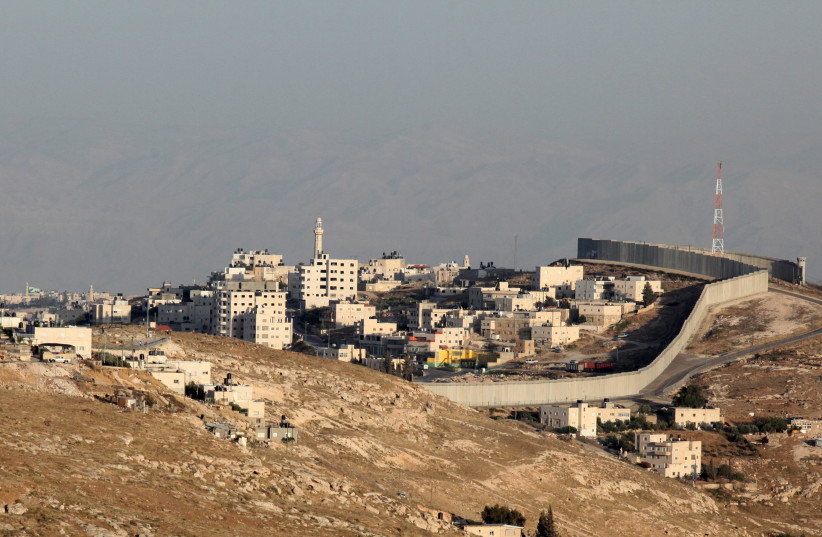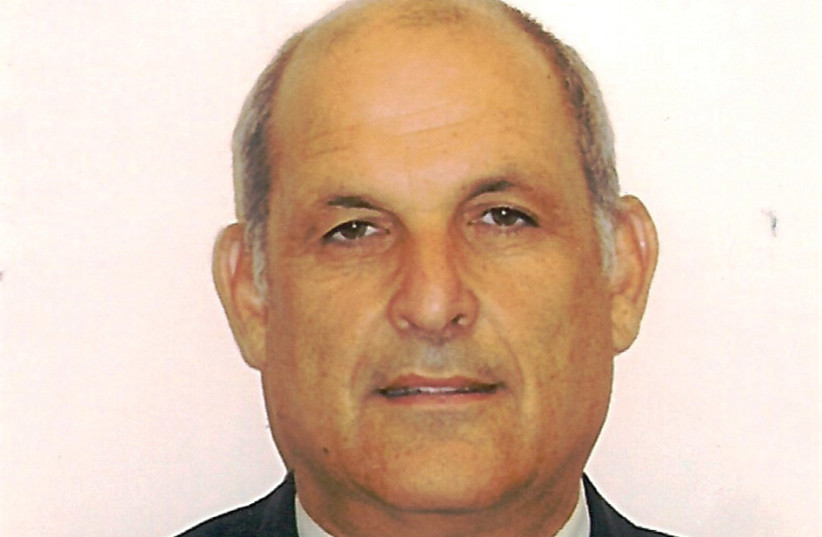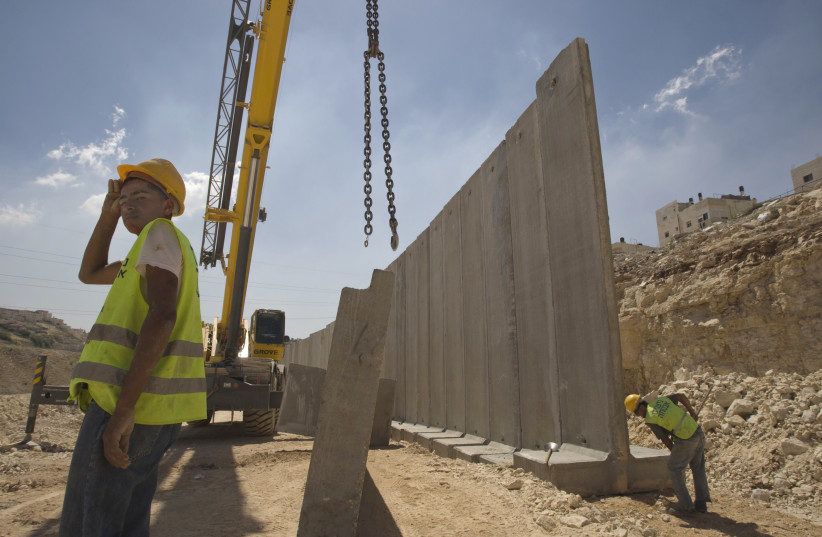Semantics matter in the Israeli-Palestinian conflict.
Is it the West Bank or Judea and Samaria? Are the areas Israel gained control over in the Six Day War “occupied” territories or “disputed” ones? Do Jews beyond the Green Line live in “settlements” or “communities?”
More often than not, the word selection reflects a worldview.
This is one reason former prime minister Naftali Bennett got in such trouble with the right-wing for using the term “West Bank’’ during a press conference with US Secretary of State Antony Blinken in March. Up until then, Bennett had always referred to the areas as Judea and Samaria. Was this just a slip of the tongue, or was Bennett sliding left, semantic evidence of a changing worldview?
In the same vein, how one refers to the meandering fence built close to the Green Line at the height of the second intifada says much about a person’s politics. Call it the “separation barrier,” and you likely believe in a two-state solution and want to “separate” from the Palestinians. Call it the “security fence” or “security barrier” and you likely see it as a defensive barrier meant to save lives.

Refer to it as the “Apartheid Wall,” and it is abundantly clear where you stand. Roger Waters calls it the apartheid wall, as does – most likely – the chairperson of Ben & Jerry’s board of directors.
The anti-Israel, Boycott, Divestment and Sanctions activists have turned what they call the “apartheid wall” into the symbol of what they deem as Israel’s oppression of the Palestinians. No wonder, then, that on campuses that hold “Israel Apartheid Week” events, replicas of the wall are erected on ivy-lined quads to illustrate the purported evils of Zionism. For those referring to the barrier as an apartheid wall, it is no less than the 21st-century incarnation of the Berlin Wall, designed with one thing in mind: to quash freedom.
Except, says Danny Tirza, it isn’t.
Tirza should know – he was the chief architect and planner of the barrier, the construction of which began 20 years ago this month. At that time, Tirza was an IDF colonel who headed the Strategic Planning Unit of the Judea and Samaria Division in the IDF‘s central command – a senior position he held from 1994-2007.
He was the IDF’s maps expert – Yasser Arafat referred to him as “Abu Kharita,” or father of the map – who advised prime ministers and defense ministers and took part in numerous rounds of negotiations with the Palestinians. He was also the Defense Ministry’s project manager for building the fence, and the person who defended it and its route 124 times in front of the High Court of Justice.
That the Palestinians have been able to cast the barrier as a symbol of Israeli “apartheid,” just shows that “they always succeed much more in their public relations than we do,” Tirza says in an interview marking 20 years since the construction of the barrier began,
Numbers, he shows, are useful in deflating their claims. And the numbers are straightforward.
According to Tirza, there were more than 3,000 attacks that originated from Judea and Samaria from September 2000 until the end of 2006 that resulted in the deaths of 1,622 people killed inside the Green Line in terrorist attacks.

From 2007, when most of the existing fence was up, until today, he says there have been 141 attacks from Judea and Samaria inside Israel, that led to the killing of some 100 people.
Those numbers tell the whole tale, he maintains. The fence wasn’t set up as a border or as a means of suppressing the Palestinians, but rather to save lives. And the numbers show it succeeded in fulfilling that objective.
It was not successful in doing this alone, he stresses. The barrier is only one component of a larger security system. It does not stand alone.
“You can’t just build physical infrastructure, without the necessary security activity around it needed to maintain it,” he says. That means the fence needs soldiers to patrol the barrier, electronic devices to monitor it, lookout posts along its route, passages to allow for orderly crossing, and constant intelligence.
“Everything working together creates an effective security apparatus,” he says. “The minute part of this doesn’t work, the whole story doesn’t work, and that is what happened when the IDF, three or four years ago, removed some of the IDF forces along the fence. The Palestinians took advantage of that and breaches in the fence were created, which the army – for various reasons – did not do anything to close.”
Tellingly, the mini-wave of terror earlier this year, during which 19 people were killed in six weeks starting in late March, led to a decision to repair the barrier where it had been damaged, and plug holes through which some of the terrorists who carried out those attacks moved across the Green Line.
The security fence alone did not bring down the number of terror attacks – this was done through a combination of offensive and defensive steps – but it was, he asserts, a critically important component.
Building the fence and political considerations
THE FORMAL decision to erect the security barrier was made by Ariel Sharon’s government in June 2002, three months after the Passover eve massacre at the Park Hotel in March.
Following that attack, which happened during a brutal month during which 139 people were killed in terrorist attacks, Sharon embarked on a three-pronged approach to bringing the terror to heel, Tirza remembers.
The first prong was a military operation – Defensive Shield. This was an offensive military campaign that brought the IDF back into the Palestinian cities from which it had withdrawn under the Oslo accords.
The second prong was to prepare a security barrier as a defensive tool.
And the third prong was to prepare a political horizon, which culminated in a speech by then-president George W. Bush delivered at the end of June 2002, in which he said that if the Palestinians changed their leadership, reformed their institutions and fought error, then the US would work toward the creation of a two-state solution.
“Sharon always thought big, and wanted to deal with the violence through all aspects: offensive, defensive and with a diplomatic horizon.”
Danny Tirza
“Sharon always thought big, and wanted to deal with the violence through all aspects: offensive, defensive and with a diplomatic horizon.”
“The beginning of the construction of the fence needs to be put in context,” Tirza stresses, “and the context was the terror campaign launched by Arafat in September 2000. This violence came six weeks after the collapse of Camp David [where Ehud Barak met with Arafat and Bill Clinton]. It is impossible to divorce the two events. What happened was that Arafat tried to get through a terror campaign what he was unable to get around the negotiating table.”
Tirza – drawing attention again to one of the semantic issues in describing the Israeli-Palestinian conflict – skews the use of the term “intifada,” believing that it is a loaded word that shapes reality and is favorable to the Palestinian narrative. In an article he wrote 10 years ago, he maintained that Israelis have “unwittingly,” adopted the “Palestinian name, the Second Intifada, thus actually accepting the view that confirms Palestinian valor in steadfast resistance, and legitimate opposition, to Israeli occupation.”
TIRZA WAS intimately involved since the beginning of the Oslo process in the “territorial piece” of the negotiations with the Palestinians and had drawn up maps dealing with what Israel believed needed to be in any future agreement. Already in December of 1994, the IDF had given then-prime minister Yitzhak Rabin maps of what it viewed Israel needed for its security, with a fence being one component of those security requirements.
As a result, from 1994 to 2000 a couple of sections of the fence were built, one near Kalkilya and the other near Tulkarm, but there was little enthusiasm for building a continuous fence for fear of its diplomatic implications.
This thinking, however, changed dramatically, he says, with the outbreak of violence in September 2000, “as we then understood the lack of good faith on the other side and the need to increase the security element.”
From September 2000, the National Security Council presented the government with proposals on how to fight terror not only from the point of view of going on the offensive, but also from a defensive posture as well.
“At that time the idea was to build some barriers, but not a continuous fence because that had diplomatic significance,” he says. Rather, the idea was to erect some barriers that would make it easier for the IDF to prevent terrorists from crossing the Green Line.
Sharon, Tirza recalls, was adamantly opposed to a fence, fearful that this would eventually be a border. Yet, because of the mind-numbing terrorism, he was under both public and political pressure to do something. The public pressure came from an organization set up by former National Security Council head Uzi Dayan called Security Fence for Israel, and the political pressure was spearheaded by then-Labor MK Haim Ramon.
When a decision was finally made to go ahead and green light the fence, according to Tirza, major disagreements regarding the route emerged inside what at the time was a national unity government that included the Labor-Meimad party headed then by Shimon Peres.
Tirza says that the chief of staff at the time, Shaul Mofaz, wanted the fence to run much further east than its route today, around the major Palestinian cities and not near the Green Line. Defense minister Benjamin Ben-Eliezer of Labor wanted it to approximate the Green Line, while Peres “opposed the erection of the fence because he thought it would prevent any future diplomatic moves.”
In addition, he says, some on the Right, such as the environment minister at the time Tzahi Hanegbi, said that the only fence needed was along the Jordan river, while others wanted to route the fence around the concentration of Israeli-Arab towns adjacent to the Green Line known as the Triangle, to put the Arabs there on the Palestinian side of the fence.
Tirza says that among the settlement leaders some objected to any kind of fence because of a concern that it would eventually be the border between Israel and some kind of Palestinian entity, and that those settlements outside the fence would eventually be uprooted.

“I had in my mind a map that I thought we could go with in a diplomatic arrangement,” he says, adding that the principle that guided him was to provide maximum security for Israel while having minimal impact on the lives of the Palestinians.
“I had in my mind a map that I thought we could go with in a diplomatic arrangement.”
Danny Tirza
During the building of the fence, there were 124 petitions to the High Court of Justice. In five of these cases, the court demanded changes in the route of the fence. Practically, what the court did, Tirza says, was adjust the balance between the needs of the Palestinian residents impacted by the fence and the security needs of the state.
Critics of the barrier say that its real purpose was not to defend against terror but to expropriate Palestinian land, though only 8% of West Bank land is inside the fence. They also decry the hardships it has caused, restricting Palestinians’ movement and, in some cases, separating Palestinian farmers from their land.
Tirza acknowledges that hardships were caused, but stresses that great efforts were made to ease the hardships. Also, he notes, not one Palestinian home was demolished in building the barrier.
He rejects the idea that the fence is an attempt to annex part of the territories, saying that it was meant to be – and remains – only a security barrier. Further, he says the line delineating a future border can only be agreed upon around a negotiation table.
“The fence is only a temporary security route that will be changed the minute we sit and negotiate and agree on a border.”
Danny Tirza
“The fence is only a temporary security route that will be changed the minute we sit and negotiate and agree on a border,” he says. “Israel has always said, even after negotiations with the Palestinians after the fence was built – at Annapolis [in 2007] – that the fence is not a border, but a defensive measure. Different considerations will come into play when there will be discussions about where a border will be.”
There were politicians, like former foreign minister Tzipi Livne, who believed that the final lines should run along the route of the fence, but Israel’s position has always been that it was open to changes, he says.
Looking back two decades to the start of work on the fence, Tirza says that despite the abundant criticism, he is satisfied with what was accomplished. “We succeeded in saving many lives, even if there are those who didn’t like the fence, even if it caused some damage to people from various sides. In the final result, we saved many lives – and that is the most important thing.” ■
The security fence: long and costly
Government approval for the construction of the security barrier came on June 23, 2002, and work began about a month later.
“The construction of security fences and obstacles in the seam area and in the Jerusalem envelope,” read the cabinet decision announcing the decision to construct the fence, is “for the purpose of reducing the infiltration of terrorists from Judea and Samaria to carry out attacks in Israel. The fence, like the other obstacles, is a security measure. It does not establish a border, political or otherwise.”
Some 470 km. of the barrier has been erected. Various routes of the fence have been proposed, with the original route planned to be some 740 km. The route was modified several times over the years by the High Court of Justice following petitions from human rights groups representing Palestinians.
For most of its length, the barrier is a chain-linked fence with sensors, surveillance cameras, barbed wires and patrol roads. Only some 5% of the barrier is actually a 9-meter tall concrete wall, and most of that is in urban areas – such as Jerusalem – where a wall takes up much less space to build.
Israel disregarded a nonbinding International High Court of Justice ruling on the barrier in 2004, which determined that the barriers built on land beyond the Green line were “contrary to international law.” About 85% of the barrier runs within Judea and Samaria and the other 15% runs along the Green Line.
In April, following a mini-wave of terror, the Defense Ministry began work to build a 9-meter tall wall to replace a 45-km. stretch of fence that was breached in the Bat Hefer region, with some NIS 300 million allocated for the work.
At that time, State Comptroller Matanyahu Englman published figures saying that the fence has so far cost NIS 8 billion, a number that included some NIS 140m. spent each year on upkeep and maintenance.
